


 |
June 1, 2013: Our Last Day in South Dakota |
 |
May 30, 2013: The Badlands of South Dakota |
 |
Return to the Index for Our South Dakota Trip |
Today, the four of us spent the day with Guy in and around Chamberlain. We did two major things- visited the St. Joseph's Indian School that is run by Guy's order and then drove out in the countryside to the two other churches that Guy serves as priest for.
St. Joseph's Indian School
|
In his trips to San Antonio, and earlier this week, Guy had told us something of the history of the Indian School, and about the commitment his order has to its operation and success. But since you haven't had the benefit of that explantion, I thought I'd give you a short history of the Indian School that we were about to enter.
A Capsule History of SJIS
|
From the diaries left by the sisters, we learn about the government doctors and a nurse who visited the school regularly to monitor the health of the students; they performed tonsillectomies and other minor operations. We also learn about the harsh winters and frozen water pipes as well as the extreme hardship brought on by the Great Depression. Sometimes the Sisters themselves fell ill and had to leave their work at the school. Sadly, many of the children were undernourished and sickly, coming to the school from the poor environment of the reservation; some had lost both parents. The priests and Sisters did their best, but could not save every student.
But we also learn about holiday celebrations- like Christmas and Easter- which, apparently, brought much joy to students and staff. The history of the school is replete with stories of good times and bad. A number of the students excelled academically, a few of them outranking almost all other students in the county- an even greater achievement when one considers that the students spent only a half day in class, the rest of the time being devoted to vocational training.
In 1941, Father Henry, St. Joseph's founter, and another priest were killed in a car accident outside Chicago, where they had gone to address a meeting about the Order's work at the Indian Mission and elsewhere. This made the fall opening that year a sad affair, as new priests had to be recruited to take their places. Military training began in 1942, and the next year an eighth-grader, older that normal for the grade, was drafted and left for an army camp.
At the time of the school's 20th anniversary, the school had 221 students, with an unusual number of the very young. This made everything even more cramped but, according to one Sister's diary, "the children do not mind the limited space. At home, an entire family is often held to a one-room shack. Here they can go to school, have warm meals, learn religion, and enjoy the companionship of other little girls and boys.
|
In 1983, a transition from the dormitory model to the residential living model was completed, with each "home" housing 10-12 students. These homes were created by remodeling and repurposing the dormitories. The model remains in use today, although the transition reduced the capacity for boarding students. In 1985, Our Lady of the Sioux Chapel was completely remodeled, and brought together Catholic and Lakota traditions. In 1992, after the completion of a new school building, the old one became the the Akta Lakota Museum & Cultural Center to showcase and embrace Lakota culture. The school has continued to modernize and improve its facilities and the training it provides to its charges. Now, 80 years after its founding, St. Joseph’s Indian School boards 200 Lakota boys and girls, providing them with a safe, stable environment that responds to the needs of the whole person; it also conducts day schooling for a large number of other students.
The Akta Lakota Museum & Cultural Center
|
On the front wall of the Cultural Center we found etchings of famous Lakota chiefs. There were five of them; I have put clickable thumbnails below for three of them, and you can see Fred with the other two (Chief Hump and Chief Iron Nation) here.
 |
Just beside the entry door there was also another panel that looked like one of those Indian sand paintings you've seen; this one showed an eagle and the four compass points, recalling the extent of the Lakota Sioux. You can see that panel here. One other interesting thing I found immediately inside the doors was the floor mat done in a colorful geometric design. I thought it was very pretty, and thought that it would be nice to have one as a souvenir of the Indian School. The gift shop did not have them, and when I asked about them I learned that they were made locally by a service company that has the contract for maintaining and cleaning the museum building. I also learned that other visitors had asked about them, but that the company said they did not offer them for sale. You can see the mat here.
|
The Akta Lakota is housed in the former school building; an octagon shaped building with 14,000 square feet of display space. The museum’s collection features art, artifacts and educational displays that depict the proud heritage of the Lakota people. Much of the museum’s original collection came from gifts given to St. Joseph’s by alumni and friends since the school opened in 1927. Since the museum opened, it has acquired many new pieces and continually strives to add relevant pieces to the collection. The museum also houses a Collector’s Gallery, which gives local artists a place to display and sell their work.
The facility is more than a traditional museum; it is an experience that provides visitors with a living lesson on the Native American way of life, both past and present.
The museum, which occupies a few different wings, was spacious, well-laid-out and very interesting. We spent a good deal of time inside looking at all the exhibits, which were very well done. We also found some interesting items in the two gift shop areas, and I think that each of us, save Guy, bought something to take home.
We took lots of pictures, and I'd like to include most of the good ones here. What I'll do is simply divide them into sections to make it a little easier for you to look at what might interest you.
Artwork
|
|
Culture Exhibits
|

|
Fred took some more pictures of the interesting displays, and if you'd like to have a look at them you can use the clickable thumbnails below:
 |
The Timeline
"Two Nations and One Land" (1838-1860)
"Conflict and Loss" (1860-1890)
"The Circle is Unbroken" (1911-1928)
"Too Today" (1980-2011)
Aspects of Lakota Life and Culture
|
"The Wind Center"
|
"In the Beginning"
|
|
"The Reservation Era"
|
"Reservations"
|
|
"Childhood on the Plains"
|
"Neither Farmer Nor Indian"
|
|
"Growing Up Male"
|
"Becoming a Man"
|
|
"Becoming a Woman"
|
"Circle of Seasons"
|
|
"The Onslaught Settlement"
|
"Harper's Weekly: Buffalo and Settlers"
|
|
"Railroads"
|
"Mining"
|
|
"Quote from Crazy Horse"
|
"Quote from Spotted Tail"
|
|
"Quote from Red Cloud"
|
"Quote from Sitting Bull"
|
The Buffalo in Lakota Life and Culture
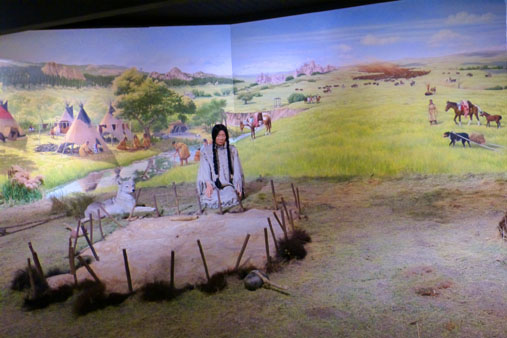 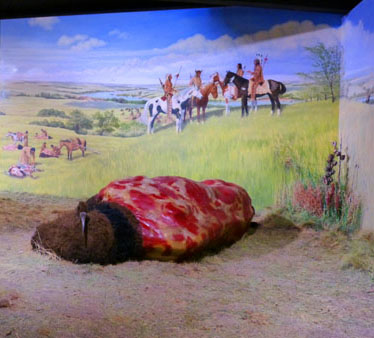 |
|
"The Buffalo Hunt"
|
"Bounty from the Buffalo"
|
|
"The Buffalo: Giver of All Things"
|
Sculpture and Other Craft Art
|
Another interesting piece is actually the logo of the Akta Lakota museum; it was sculpted out of alabaster in 1996 by an alumnus of the Indian School, Alfred Ziegler (1918-2012). In the gift shop, there was a display of Indian‑made quilts; Prudence was attracted to them, so she and Guy picked one out for Prudence to take home.
Below are clickable thumbnails for some additional pictures that Fred took as we wandered through the museum:
 |
One wing of the museum was devoted to the history of the Indian School and to the influence of the Catholic Church and particularly the Order of the Priests of the Sacred Heart in South Dakota and on the Lakota Indians. Fred photographed two of the explanatory signs, and you can read them using the two scrollable windows below:
|
"Catholics in South Dakota"
|
|
"The Priests of the Sacred Heart"
|
The Medicine Wheel Garden
|
On the brick outside wall of the museum was a purpose statement for the garden, and I thought it was interesting. You can read that statement here.
The garden fuses both the traditional and the contemporary to create an atmosphere conducive to both healing and learning while being mindful of the many and diverse constituents.
Arrayed around the structure are seven simulated buffalo hide inscriptions that are intended to remind one of the directions and influences on one's life; these concepts are taken from Lakota culture. They are interesting to read, and you can do so using the clickable thumbnails below:
 |
Our Lady of the Sioux Chapel
|
As is the practice at St. Joseph's, everything is an amalgam of Lakota culture and Catholic teachings; this carries into ritual and architecture/decoration. On the front of the chapel, above the entrance, was a sculpture of Our Lady of the Sioux shepherding a Lakota child. I found the representation to be at the same time quite pretty and quite interesting, in the sense that sculptures of Catholic saints that we have seen in our travels are usually all similar in the way they look (whether men or women). They have the appearance of having been sculpted in the style of classical antiquity, whether one finds them in an old European cathedral or a modern American Catholic church.
But here, the Lady is indeed represented as very much an Indian, right down to the native dress and the feather in the hair. Perhaps you don't find this a bit odd, although I did. But I understand the effort to make the Church relevant for the populations it serves. Fred took a closeup picture of the sculpture that shows more detail, and you can have a look at it here. Before going inside, Fred also took a picture of the other four of us outside the chapel.
|
Along each wall of the actual chapel there was a series of stained glass windows, each of the eight a double panel with one side having a particular Indian design (Guy told us that each had a meaning) and the other a small scene depicting an event or person important in the ministry of the Priests of the Sacred Heart to the Lakota. Fred took pictures of each double panel, and you can have a look at them by using the clickable thumbnails below:

|
Fort Thompson and a Drive Through the Hills
|
Guy took us by the Lower Brule Tribal Headquarters, where the tribe administers its reservation. It sits up on a hill overlooking the river.
We crossed the river to the west, and following the county road west and south towards I-90. The area is typically very rural, with horses and livestock in the pastures. The landscape has its own kind of lonely beauty.
We arrived back at the Interstate and headed east back towards Chamberlain passing the tourist stop known as Al's Oasis, which is just on the west side of the Missouri right at Chamberlain. We continued east across the river to visit the first of the two other churches for which Guy is responsible.
St. Procopius Church: Guy's Country Church
|
|
 |
The decoration was minimal, and it reminded me of nothing so much as the kind of small church you might have seen in a western movie. The fresh flowers we found in the chapel were, apparently, for that wedding. There are clickable thumbnails below for a few more pictures of the inside of this small church:
 |
Saint Anthony's Church
|
 |
The inside of Saint Anthony's was nice for such a small town church. There was even a choir loft at the back of the chapel (above the small vestibule). The altar was flanked by two small stained glass windows, and there were more windows along the sides of the chapel.
Fred was interested in the medallions in each window; they seemed to be directed towards a number of subjects that would have meaning for a rural town in farming country. He took closeup pictures of five of these windows, and I've extracted just the medallions so you can see them:
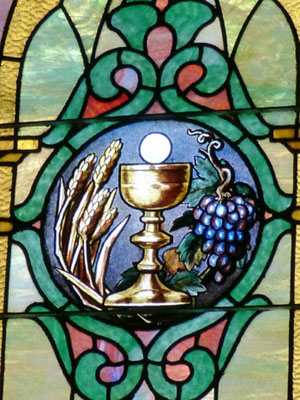 |
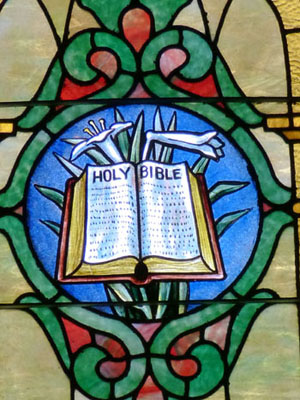 |
 |
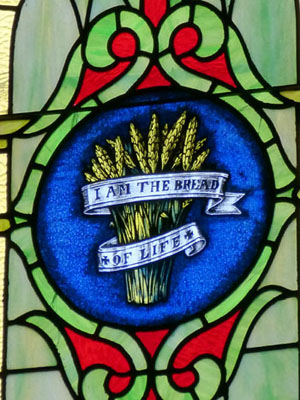 |
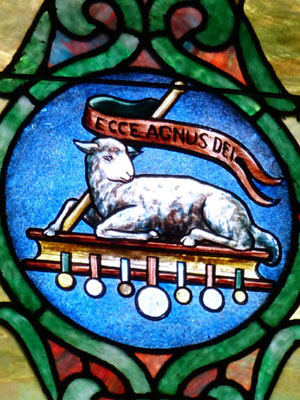 |
From Pukwana, we drove back to Chamberlain so Guy could do his evening service. After he was done, we all put a meal together using a large lasagne that one of Guy's parishioners had given him. With a salad and some garlic bread and dessert, we had a really nice meal. After which the gang lasted through about thirty minutes of "Cloud Atlas."
You can use the links below to continue on through the photo album.
 |
June 1, 2013: Our Last Day in South Dakota |
 |
May 30, 2013: The Badlands of South Dakota |
 |
Return to the Index for Our South Dakota Trip |